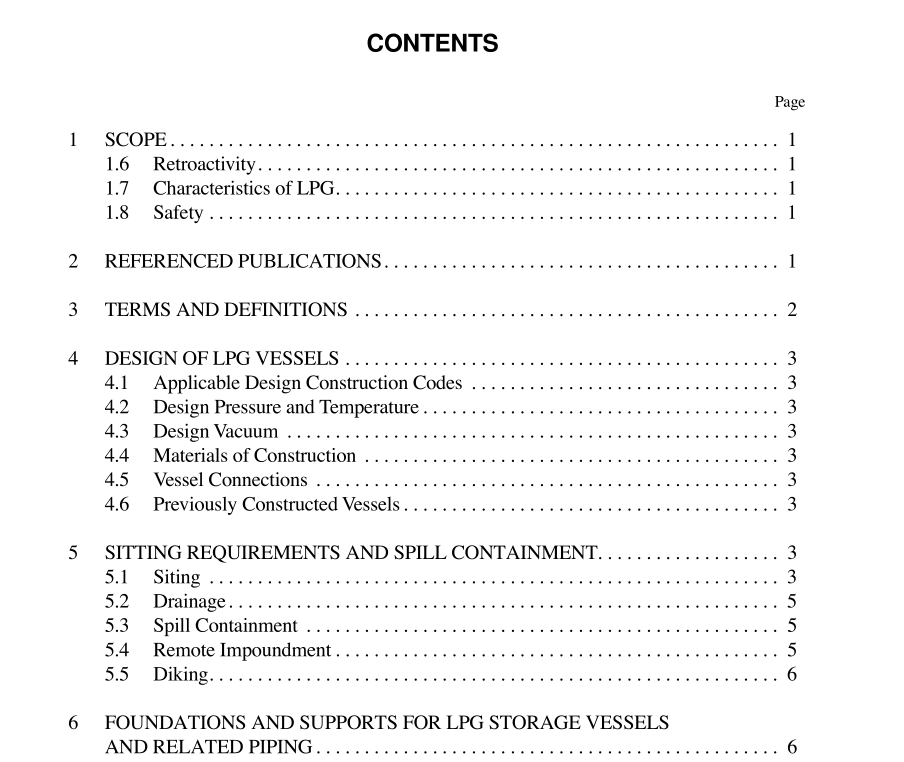API std 2510 pdf download

API std 2510 pdf download.Design and Construction of LPG Installations
1 Scope
This standard covers the design, construction, and location of liqueÞed petroleum gas (LPG) installations at marine and pipeline terminals, natural gas processing plants, reÞneries, petrochemical plants, or tank farms. This standard covers storage vessels, loading and unloading systems, piping, or and related equipment. 1.1 The size and type of the installation; the related facili- ties on the site; the commercial, industrial, and residential population density in the surrounding area; the terrain and cli- mate conditions; and the type of LPG handled shall be con- sidered. Generally speaking, the larger the installation and the greater the population density of the surrounding area, the more stringent are the design requirements. 1.2 Design and construction considerations peculiar to refrigerated storage, including autorefrigerated storage, are covered in Section 9 of this standard. 1.3 In this standard, numerical values are presented with U.S. customary units only. These U.S. customary values are to be regarded as the standard values. 1.4 This standard shall not apply to the design, construc- tion, or relocation of frozen earth pits, underground storage caverns or wells, underground or mounded storage tanks, and aboveground concrete storage tanks. 1.5 This standard does not apply to the following installa- tions: a. Those covered by NFPA 58 and NFPA 59. b. U.S. Department of Transportation (DOT) containers. c. Gas utility company facilities; reÞnery process equipment; reÞnery and gas plant processing equipment; and transfer sys- tems from process equipment upstream LPG storage. d. Those tanks with less than 2000 gallons of storage capacity. 1.6 RETROACTIVITY The provisions of this standard are intended for application to new installations. This standard can be used to review and evaluate existing storage facilities.
3 Terms and Definitions
Some of the terms used in this standard are deÞned in 3.1 through 3.13. 3.1 aboveground tank or aboveground vessel: a tank or vessel all or part of which is exposed above grade. 3.2 autorefrigeration: the chilling effect of vaporization of LPG when it is released or vented to a lower pressure. 3.3 boiling-liquid expanding-vapor explosion (BLEVE): the phenomenon of a pressurized LPG tank failing such as can occur from direct exposure to a Þre (normally a catastrophic event). 3.4 installations: tanks, vessels, pumps, compressors, accessories, piping, and all other associated equipment required for the receipt, transfer, storage, and shipment of LPG. 3.5 liquefied petroleum gas (LPG or LP-gas): any material in liquid form that is composed predominantly of any of the following hydrocarbons or of a mixture thereof: propane, propylene, butanes (normal butane or isobutane), and butylenes. 3.6 mounded tank or mounded vessel: a tank or ves- sel located above or partially above the general grade level but covered with earth, sand, or other suitable material. 3.7 refrigerated storage: storage in a vessel or tank arti- Þcially maintained at a temperature below the nominal ambi- ent temperature. 3.8 rollover: the spontaneous and sudden movement of a large mass of liquid from the bottom to the top surface of a refrigerated storage reservoir due to an instability caused by an adverse density gradient. Rollover can cause a sudden pressure increase and can affect vessel integrity. 3.9 shall: indicates provisions that are mandatory. 3.10 Use of the term shall consider directly before a design or construction factor (such as a force or safety) indi- cates that the factorÕs effects and signiÞcance shall be evalu- ated using good engineering judgement-through an examination or test if appropriate-and the design may or may not be adjusted accordingly.3.11 tank or vessel: a container used for storing LPG. 3.12 underground tank or underground vessel: a tank or vessel all parts of which are completely buried below the general grade of the facility.









